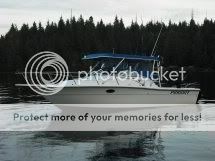Braid versus Cable is very much a personal preference. There is “no” advantages for “me” to switch to braid and many “disadvantages” for “me”! Biggest issue, I have “Cannon Downriggers”, with “positive ION and “quick stop”. Plus, I just prefer cable!
Concerning the “black box”, I would tend to agree with IFL… it “probably” would not help, most?
I can’t say a “black box” will or will not help you catch fish, as that depends on how you fish! It has been proven that positive IONs do attract fish. However, it has also been proven if your downrigger is at depth or your drop back is so far back, there probably won’t be any effect one way or the other? That small amount of current will only travel so far at any setting. Even if your boat is hot, (which does need fixed)… that current will also only travel so far!
Replacing cable every year… quit buying that “cheap” crap!
My cables are well over five years old. I do admit, I rinse them with fresh water after each use and have been known to spray everything down with WD40, but my downriggers are also exposed to salt air 24/7 and have been since 2006. Cannon actually recommends changing the cable after two years, but I will keep mine until I start having breaking issues? The loss of any of the “positive ION”, is “not” even a concern, to me. Also, any line (including wire and braid) will degrade with use and over the years, regardless of what it is made from… including “ProwerPro”!
The “Palomar Knot”… You bet, that would be one of the knots of choice with braid or mono. But, if anyone believes you are not reducing the breaking strength of “any” line by trying a knot in it… you might want to do some homework? The only question is “how much”! If any part of the knot over laps itself… you should consider you just reduced breaking the strength 50%! Answer is simply, buy a larger line?
If “I” were to use “braid”, it would be “PowerPro Downrigger”… As all braid is “not” equal!
Construction of Braided Lines: Braided lines are exactly what they sound like...strands of fiber forming a regular diagonal pattern down the entire length of the spool. PowerPro is braided using 4 strands, each is composed of scores of exceptionally thin Spectra fibers. While a 3 strand line comes out to be flat, PowerPro comes out square but appears relatively round due to its thin profile. Prior to braiding, each strand is coated and with closer examination you will notice the individual braids. Coating the line gives it a harder and thinner profile that has a number of advantages and disadvantages, and we'll explicate more on these factors during our tests.
http://www.tackletour.com/reviewpowerpro.html
We were amazed to find the 37kg spectra samples broke at 21.5 kg in the granny knot test. This is 57% of the rated breaking strain and much higher than we thought possible.
We then went on to try a series of other popular knots and, as expected, a bimini twist (a complex fishing line twist knot) was found to be one of the best breaking at 27kg or 73% of the rated breaking strain.
Other popular mono knots, like a uni knot and clinch knot were little better than the granny knot when tied into the spectra line and we do not recommend using them.
After looking at the various knots under strain with a powerful magnifying glass it was obvious that spectra cuts into spectra just as easily as mono will cut into mono.
Also, because spectra is so slippery, the knots pull up incredibly tightly, further compounding the issue.
http://www.caves.org/section/vertical/nh/50/knotrope.html
http://www.animatedknots.com/indexfishing.php?
